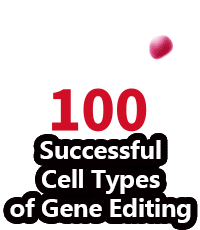Location: Homepage > Gene Editing Services > Stable Cell Lines >

Schauen Sie sich unsere Liste der ZelllinienClick Here
Human bladder carcinoma cell line (TCCSUP)
Human bladder carcinoma cell line (5637)
Human Bladder Transitional Cell Carcinoma Cell Line (T24)
Human Adrenal Cortical Adenocarcinoma Cell Line
Mouse Mesangial Polyoma Cell Line
Rat Glomerular Mesangial Cell Line
Human Kidney Cell Line
Rhesus Monkey Kidney Cell Line
Human Renal Carcinoma CellLine
Human Embryonic Kidney Cell Line(HEK293)
Human Embryonic Kidney Cell Line(derived from 293)
Madin-Darby Canine Kidney Cell Line MDCK(NBL-2)
Human prostate carcinoma cell line (22RV1)
Mouse Macrophage Cell Line (RAW264.7)
Human Monocytic Cell Line (THP-1)
Human Erythroleukemia Cell Line
Human Leukemic Cell Line
Mouse Acute Myeloid Leukemia Cell Line
Mouse Myeloid Progenitor Cell Line
Rat Basophil Leukemia Cell Line (RBL-2H3)
Human leukemia cell line (HL-60)
Human T lymphocyte cell line (Jurkat, Clone E6-1)
Human myelogenous leukemia cell line (K-562)
Human caucasian histiocytic lymphoma cell line (U937)
Human B Cell Lymphoma Cancer Cell Line U2932
Human B Cell Lymphoma Cancer Cell Line OCI-LY3
Human Acute Non-B Non-T Lymphocytic Leukemia Cell Line (Reh)
Human Bronchial Epithelial Cell Line (16HBE)
Human Lung Cancer Cell Line (A549)
Human Lung Cancer Cell Line (Calu-1)
Human Lung Cancer Cell Line (Epithelium)
Lewis lung carcinoma (LLC)
Human Non-small Cell Lung Carcinoma Cell Line (H1299)
Human Non-small Cell Lung Carcinoma Cell Line (HCC827)
Human Lung Adenocarcinoma Cell Line
Human Bronchial Epithelial Cell Line (BEAS-2B)
Human Bronchial Epithelial Cell Line
human embryonic lung fibroblasts
Human fetal lung fibroblast cell line (MRC-5)
Human hypopharyngeal carcinoma cell line (FaDu)
Human Lung Squamous Cell Carcinoma Cell Line NCI-H226
Human Small Cell Lung Cancer Cell Line H69AR
Chinese hamster lung cells (V79)
Human Breast Cancer Cell Line (MDA-MB-231)
Rat Breast Cancer Cell Line (4T1)
Human Pancreatic Carcinoma Cell Line (PANC-1)
Human breast cancer cell line (MCF-7)
Human Breast Adenocarcinoma Cell Line (SK-BR-3)
Human Metastatic Pancreatic Adenocarcinoma Cell Line (AsPC-1)
Human Pancreatic Carcinoma Cell Line (MIA PaCa-2)
Human Pancreatic Carcinoma Tumor Cell Line
Mouse Pancreatic Carcinoma Cell Line (PANC-1)
Human Prostate Cancer Tumor Cell Line
Human prostate cancer cell line (PC3)
Human prostate cancer cell line (LNCaP)
Mouse Acinar Pancreatic Cell Line (266-6)
Human pancreatic cancer cell line (BxPC-3)
Human Breast Cancer Cell Line MDA-MB-468
Human Breast Cancer Cell Line MDA-MB-453
Human Breast Cancer Cell Line MDA-MB-436
Human Breast Cancer Cell Line ZR-75-1
Human Breast Cell Line MCF10A
Mouse Pancreatic Carcinoma Cell Line Capan-2
Human Ductal Carcinoma Cell Line BT-474
Human Prostate Cancer Cell Line VCaP
Human Vulvar Leiomyosarcoma Cell Line
Rat Cardiac Myocytes (H9C2)
Human Coronary Artery Endothelial Cell line (HCAEC)
Mouse Myoblast Cell Line (C2C12)
Human Colon Cancer Cell Line (HCT116)
Human Colon Cancer Cell Line (SW480)
Human Colon Cancer Cell Line (SW620)
Human Colon Cancer Cell Line (HT-29)
Human Colon Cancer Cell Line (LoVo)
Human colon carcinoma cell line (RKO)
Human caucasian colon adenocarcinoma cell line (COLO 205)
Murine colorectal carcinoma cell line (CT26.WT)
Human colon adenocarcinoma cell line (DLD-1)
Human colorectal adenocarcinoma cell line (NCI-H716)
Human colorectal adenocarcinoma cell line (Caco-2)
Human colon carcinoma cell line (T84)
Human liver cancer cell line (Hep G2)
Human Hepatoma Cell Line (Hep3B)
Human hepatocellular carcinoma cell line (HuH-7)
Human Hepatocellular Carcinoma Cell Line
Rat Hepatoma Cell Line
Rat Hepatoma Cell Line
Human Primary Colon Cancer Cell Lines
Human Gastric Cancer Cell Line (HGC-27)
Human gastric cancer cell line (AGS)
Human Esophageal Squamous Carcinoma Cell Line
Human Esophageal Squamous Carcinoma Cell Line (KYSE-150)
Human renal cell carcinoma cell line (786-O)
Porcine small intestinal epithelial cell line
Murine Colorectal Carcinoma Cell Line MCA38
Human Hepatocellular Carcinoma Cell Line SNU-387
Human Gastric Cancer Cell Line SGC-7901
Human Esophageal Squamous Carcinoma Cell Line KYSE-150
Human Esophageal Squamous Carcinoma Cell Line KYSE-30
African green monkey kidney cell(Vero)
Human Osteosarcoma Cell Line (MG63)
Human bone osteosarcoma epithelial cell line (U-2 OS)
Human fibrosarcoma cell line (HT1080)
Human Osteosarcoma Cell Line
Immortalized Human Epidermal Cell Line
Mouse Chondrocyte Progenitor Cell Line
Ewing's Sarcoma Cell Line
Human Malignant Melanoma Cell Line
Human malignant melanoma cell line (A-375)
Murine melanoma cell line (B16-F10)
Human Melanoma Cell Line M14
Mouse myeloma cell line (Sp2/0-Ag14)
Rat Muller Cell Line (rmc-1)
Human Tongue Squamous Carcinoma Cell Line
Human Nasopharyngeal Carcinoma Cell Line (C666-1)
Human Nasopharyngeal Carcinoma Cell Line (cne2z)
Human Neuroblastoma Cell Line (SK-N-SH)
Mouse neuroblastoma cell line (Neuro-2a)
Human Glioblastoma Cell Line (U251)
Rat Glioblastoma Cell Line (C6)
Human Glioblastoma Cell Line
Human glioblastoma cell line (U-87 MG)
Mouse Glioblastoma Cell Line GL261
Immortalize Human Microvascular Endothelial Cell Line hCMEC/D3
Mouse Hippocampal Neuron Cell Line HT22
Mouse Anterior Parietal Bone Cell Line (MC3T3-E1 Subclone 14)
Human Cervical Carcinoma Cell Line (HeLa)
Human Ovarian Adenocarcinoma Cell Line
Mouse Embryonic Osteoblast Precursor Cells
Mouse Embryonic Fibroblasts (Preadipocytes)
Mouse Embryonic Fibroblasts (NIH/3T3)
Human Cervical Carcinoma Cell Line Hela 229
Human Cervical Squamous Cell Line SiHa
Human Ovarian Cancer Cell Line SK-OV-3
Human Ovarian Cancer Cell Line OVCAR3
Mouse Testicular Stromal Cell Line TM3
Chinese Hamster Ovary Cell Line (CHO-K1)
| Classifying Standards | Klassifikation |
|---|---|
| Größe der Knockout-Sequenz | Kurzfragment-Entfernung; Frameshift-Mutation; Großfragment-Entfernung |
| Methoden | Virustransduktion; Nukleofektion |
| Zelltypen | Tumorzellen; andere Zelllinien; IPS/ES usw. |
Kurzfragment-Entfernung. Führung-RNAs zielen auf die Introns der beiden Siten von Exon 2 und die Anzahl der Basen in Exon 2 ist kein Vielfaches von 3, was zu einer Mutation des Frameshifts führen kann.
Frameshift-Mutation. Führung-RNA zielt auf das Exon, und die Anzahl der gelöschten Basen ist kein Vielfaches von 3. Nach dem Knockout würde die Frameshift-Mutation den Knockout eines Gens verursachen.
Großfragment-Entfernung. Vollständige Entfernung der kodierenden Sequenz, um einen Gen-Knockout zu erreichen.





